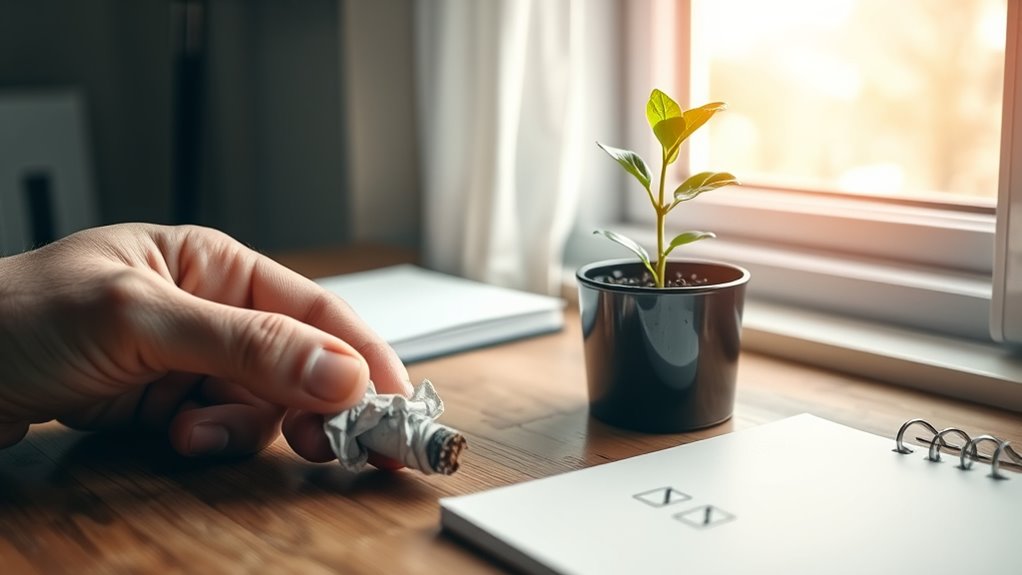To replace bad habits with good ones, identify triggers and swap negative behaviors for healthier alternatives like drinking water or taking walks. Use small steps to build new routines gradually, reinforcing them with positive rewards. Manage triggers by making environmental adjustments—such as removing temptations or placing visual cues—so good habits become automatic. Incorporate mindfulness to increase awareness. Keep working at it, and you’ll discover effective strategies that make lasting change achievable.
Key Takeaways
- Identify triggers and replace negative behaviors with healthier alternatives like water, walking, or nutritious snacks.
- Start small with manageable goals, gradually increasing efforts while reinforcing progress through celebration and mindfulness.
- Use visual cues and environmental modifications to make healthy habits more accessible and disrupt old habit triggers.
- Practice habit reversal techniques, including recognizing automatic triggers and pairing incompatible responses.
- Create a supportive environment by organizing space, removing temptations, and setting reminders to reinforce positive routines.
Swap Negative Behaviors for Positive Alternatives

To successfully replace a negative behavior, you need to identify a positive alternative that fulfills the same need. Start by pinpointing what’s driving the habit—stress, boredom, or environmental cues. Once you understand the trigger, find a behavior that provides a similar reward or relief. For example, if you’re craving a snack out of boredom, substitute it with drinking a glass of water or taking a short walk. Make the new habit simple and easy to do in the moment, like keeping healthy snacks accessible or having a stress ball nearby. When the trigger hits, immediately choose the healthier alternative. Incorporating nutritious options like chia seeds into your diet can also serve as a wholesome way to satisfy cravings and boost overall well-being. Nutritional benefits reinforce healthy habits and support your goal of replacing negative behaviors. Consistency is key—reinforce the new behavior every time the urge arises to help it stick and eventually become automatic.
Implement Habit Reversal Techniques Effectively

To implement habit reversal techniques effectively, you need to start by recognizing automatic triggers that prompt your bad habits. Once you identify these cues, practice engaging in competing responses that are incompatible with the old behavior. Consistently applying this approach helps interrupt the habit loop and strengthens your new, healthier routines. Incorporating electric bikes into your daily routine can also serve as a positive replacement activity, promoting healthier habits overall.
Recognize Automatic Triggers
Recognizing automatic triggers is a crucial first step in effectively implementing habit reversal techniques. You need to become aware of what prompts your habits—whether it’s a specific time, place, emotion, or preceding action. Pay close attention to patterns: do you bite your nails when stressed, or reach for snacks when bored? By identifying these cues, you gain control over the automatic responses your mind defaults to. Keeping a habit journal can help you track when, where, and why the habit occurs. This awareness allows you to disrupt the cycle early, making it easier to replace the behavior. Understanding contrast ratio and its impact on image quality can also help you optimize your viewing environment, creating a more immersive experience. Recognizing triggers isn’t about judgment; it’s about understanding your habits to create effective strategies for change.
Practice Competing Responses
Practicing competing responses is a powerful way to break automatic habits by deliberately choosing a behavior that conflicts with the unwanted one. When you notice the urge to engage in a bad habit, immediately substitute it with an incompatible action. For example, if you tend to bite your nails, clench your fists or place your hands in your pockets instead. This creates a physical barrier to the habit, disrupting the automatic response. Incorporating mindfulness techniques, such as deep breathing exercises, can enhance your awareness of triggers and help you stay present. Consistently applying this technique weakens the old habit loop over time. To succeed, pair the competing response with awareness of triggers and reinforce it through positive feedback. The goal is to make the new behavior as natural as possible, so it becomes your default response when the old habit’s cue appears.
Harness the Science Behind Habit Formation

Understanding how habits form is essential for making lasting changes. When you repeat a behavior consistently in the same context, your brain creates neural pathways that make the action automatic. Starting small with tiny adjustments increases your chances of success because your brain is more likely to adapt gradually. Repeating the new behavior in the same environment strengthens the habit’s automaticity, making it easier over time. Environmental cues, like keeping healthy snacks visible, reinforce your new routine. Studies show that habits become ingrained through consistent practice, often taking weeks or months. By leveraging this science, you can design your surroundings and routines to support your goals. Recognizing personality traits can help tailor your approach to habit formation, increasing your likelihood of success. Remember, persistence and repetition in the same context are key to turning new behaviors into automatic habits.
Recognize and Break Habit-Trigger Cycles

Recognizing these triggers allows you to develop strategies to embrace positive change and establish healthier habits.
Start Small and Build Gradually Toward Your Goals

Starting small is essential when trying to build new habits because it makes change more manageable and less overwhelming. You’ll find it easier to stay consistent if you focus on tiny, achievable steps. For example, if you want to exercise more, start with just five minutes a day instead of a full workout. Once that feels natural, gradually increase the time or intensity. Breaking your goal into smaller parts reduces the risk of burnout and helps you stay motivated. Celebrate each milestone, no matter how small, to reinforce your progress. Remember, big changes don’t happen overnight—they happen through consistent, incremental efforts. By building gradually, you create a sustainable routine that sticks, making it easier to replace old habits with healthier ones over time. Incorporating mindfulness techniques can also enhance your awareness and support your habit formation process.
Leverage Accountability and Reinforcement Strategies

Leveraging accountability and reinforcement strategies considerably increases your chances of maintaining new habits. When you involve others or reward yourself, you strengthen your commitment and motivation. Sharing goals with friends or joining groups creates social pressure that keeps you on track. Setting clear, achievable goals helps you measure progress and stay focused. Rewarding yourself for milestones reinforces positive behavior, making it more likely to stick. Additionally, regularly reviewing your progress keeps you mindful and aware of your habits. To maximize these strategies, consider these key points:
- Share your goals with supportive friends or groups
- Reward yourself for consistent effort and milestones
- Track your progress regularly to stay motivated
- Incorporate habit tracking tools to monitor your success effectively
These techniques create a system of accountability and reinforcement that helps embed new, healthier habits.
Make Environmental Changes to Support New Habits

You can support your new habits by rearranging your space to make healthier choices easier and more appealing. Removing triggers that prompt old, unwanted behaviors helps break the cycle and reduces temptation. By intentionally designing your environment, you create a setting that naturally encourages your desired routines. Incorporating consistent routines into your environment can further reinforce your new habits and promote long-term success.
Rearrange Physical Space
Rearranging your physical environment can substantially support the adoption of new habits by making healthy behaviors more accessible and automatic. When your surroundings are set up for success, you’re more likely to follow through without extra effort. Focus on reducing obstacles and highlighting positive options. For example, place workout clothes where you’ll see them, keep healthy snacks within reach, or set up a dedicated space for meditation. Consider these strategies:
- Place reminders or cues in visible spots to trigger your new habit
- Store unhealthy temptations out of sight or out of reach
- Create designated areas that encourage specific behaviors like stretching or reading
- Incorporate a farmhouse bedroom aesthetic to create a calming and inviting space that promotes relaxation and self-care.
Remove Habit Triggers
Environmental triggers often set off unwanted habits, but you can disrupt these cycles by making intentional changes to your surroundings. Start by identifying what prompts your old habits—whether it’s stress, boredom, or specific locations. Once you know the cues, alter your environment to make those triggers less accessible or noticeable. For example, if you tend to snack mindlessly while watching TV, remove unhealthy snacks from your living space or replace them with healthier options. If social media prompts distraction, turn off notifications or keep your phone out of reach during focused tasks. These small adjustments create a supportive environment that encourages your desired behaviors. By removing or modifying triggers, you make it easier to stick to your new habits and reduce the chances of slipping back.
Frequently Asked Questions
How Long Does It Typically Take to Establish a New Habit?
It typically takes about 21 to 66 days to establish a new habit. You’ll see progress faster if you start small and stay consistent. When you repeat the behavior in the same context and recognize your triggers, it becomes easier to make it automatic. Keep track of your progress, celebrate small wins, and don’t get discouraged by setbacks—they’re part of the journey to building lasting change.
What if I Slip and Revert to Old Habits?
Imagine your habits as a garden—sometimes weeds sprout despite your best efforts. When you slip back into old habits, donance the weeds gently, without frustration, and replant new seeds. Recognize the trigger that led you astray, then reinforce your commitment with small, consistent actions. Remember, even seasoned gardeners face setbacks; what matters is your willingness to nurture your garden back to health, one day at a time.
Can Multiple New Habits Be Built Simultaneously?
Yes, you can build multiple new habits at once, but it’s best to start small. Focus on one or two behaviors first, making them easy and consistent. Use cues and triggers to reinforce these habits, and gradually add more over time. Keep track of your progress, celebrate small wins, and don’t get overwhelmed. Building habits gradually helps make sure they stick and become part of your routine.
How Do I Stay Motivated During Setbacks?
When setbacks happen, remind yourself why you started and focus on progress rather than perfection. Celebrate small wins to stay motivated, and don’t be too hard on yourself. Revisit your goals, adjust your plan if needed, and keep visualizing success. Reach out for support when needed and remember that setbacks are part of the process—use them as learning opportunities to strengthen your commitment and keep moving forward.
Are Digital Tools Effective for Habit Tracking and Reinforcement?
Digital tools are like reliable anchors in a storm—they keep you grounded and focused. You’ll find they’re effective for tracking habits and reinforcing progress because they offer immediate feedback, reminders, and visual progress charts. These features help you stay accountable and motivated, especially when faced with setbacks. By automating reminders and celebrating small wins, digital tools make it easier to build consistency and develop new habits over time.
Conclusion
By replacing bad habits with positive ones, you can transform your life step by step. Remember, studies show that it takes an average of 66 days to form a new habit, so patience is key. As you stay consistent and leverage your environment, you’ll start noticing small wins that build momentum. Keep pushing forward—you’re capable of creating lasting change, one positive choice at a time. Your new habits are within reach; just take that first step today.








